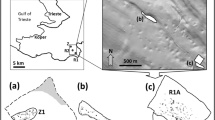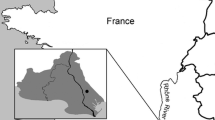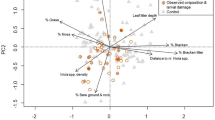Abstract
The knowledge on species’ habitat preferences at local scales across its range is an essential condition for defining the most appropriate habitat management for the conservation of any species. In this study, we combined field observations from three European countries with breeding experiments under field conditions to identify oviposition and larval preferences of Coenonympha oedippus at the micro-scale level across contrasting habitat types (wet vs. dry). Despite the wide geographical range and the different habitats we found some common features: (1) vegetation structure of the herb layer is an essential factor for oviposition site electivity and successful development of premature stages; (2) high cover of litter and/or dwarf shrubs in the microhabitat (larval 45–70 %, oviposition 40–50 %) creates a herb layer rich in gaps; at their edges eggs are deposited and the caterpillars are adequately sun-exposed; (3) egg-laying females are not selective regarding oviposition substratum; (4) oviposition height is adjusted to positions with direct sunlight or warm substratum; (5) the host-plants coverage in oviposition sites was high: between 45 and 50 % in wet habitats, and between 18 and 41 % in dry habitats (depending on whether only plants observed as hosts in this study are counted, or whether all potential host species are included); (6) the most important host-plant is Carex panicea (wet) and Carex humilis (dry), but Molinia caerulea (wet) and Festuca rupicola (dry) are also used regularly; (7) the availability of winter-green host-plants in the vicinity of hibernated larvae plays a substantial role in their survival. As regular mowing or grazing would remove the litter and destroy the gaps, the management should be restricted to selective reed cutting or manual shrub removal. Only selective mowing during winter (December–February) can be recommended for keeping the habitat open where the reduction of bushes is not sufficient.

Similar content being viewed by others
References
Anthes N, Fartmann T, Hermann G, Kaule G (2003) Combining larval habitat quality and metapopulation structure—the key for successful management of pre-alpine Euphydryas aurinia colonies. J Insect Conserv 7:175–185
Anthes N, Fartmann T, Hermann G (2008) The Duke of Burgundy butterfly and its dukedom: larval niche variation in Hamearis lucina across Central Europe. J Insect Conserv 12:3–14
Awmack CS, Leather SR (2002) Host plant quality and fecunditiy in herbivorous insects. Annu Rev Entomol 47:817–844
Balletto E, Bonelli S, Cassulo L (2007) Insecta Lepidoptera Papilionoidea. In: Ruffo S, Stoch F (eds) Checklist and Distribution of the Italian Fauna. 10.000 terrestrial and inland water species, 2nd and revised edition, Verona, pp 257–261
Balletto E, Bonelli S, Zilli A (2014) Lepidotteri. In: Genovesi P, Angelini P, Bianchi E, Dupré E, Ercole S, Giacanelli V, Ronchi F, Stoch F Specie e habitat di interesse comunitario in Italia: distribuzione, stato di conservazione e trend. ISPRA, Serie Rapporti, 194/2014
Beyer LJ, Schultz CB (2010) Oviposition selection by rare grass skipper Polites mardon in montane habitats: advancing ecological understanding to develop conservation strategies. Biol Conserv 143:862–872
Bischof A (1968) Coenonympha oedippus Fabricius, eine kleine Chorographie (Lepidoptera, Satyridae). Mitt Ent Ges Basel 18:41–63
Bonelli S, Canterino S, Balletto E (2010) Ecology of Coenonympha oedippus (Fabricius, 1787) (Lepidoptera: Nymphalidae) in Italy. Oedippus 26:25–30
Bräu M, Dolek M (2013) Wald-Wiesenvögelchen Coenonympha hero (Linnaeus, 1758). In: Bräu M, Bolz R, Kolbeck H, Nunner A, Voith J, Wolf W (eds) Tagfalter in Bayern. Eugen Ulmer, Stuttgart, pp 472–475
Bräu M, Schwibinger M (2013) Moor-Wiesenvögelchen Coenonympha oedippus (Fabricius, 1787). In: Bräu M, Bolz R, Kolbeck H, Nunner A, Voith J, Wolf W (eds) Tagfalter in Bayern. Eugen Ulmer, Stuttgart, pp 460–463
Bräu M, Dolek M, Stettmer C (2010) Habitat requirements, larval development and food preferences of the German population of the False Ringlet Coenonympha oedippus (Fabricius, 1787) (Lepidoptera: Nymphalidae)—research on the ecological needs to develop management tools. Oedippus 26:41–51
Čelik T (1997) Ecological researches of endangered species Coenonympha oedippus Fabricius, 1787 (Lepidoptera: Satyridae) on the Ljubljansko barje. M.Sc. thesis; University of Ljubljana
Čelik T (2003) Population structure, migration and conservation of Coenonympha oedippus Fabricius, 1787 (Lepidoptera: Satyridae) in a fragmented landscape. Ph.D. thesis; University of Ljubljana
Čelik T (2004) Population dynamics of endangered species Coenonympha oedippus Fabricius, 1787 (Lepidoptera: Satyridae) on the Ljubljansko barje. Acta Entomol Slov 12:99–114
Čelik T, Verovnik R (2010) Distribution, habitat preferences and population ecology of the False Ringlet Coenonympha oedippus (Fabricius, 1787) (Lepidoptera: Nymphalidae) in Slovenia. Oedippus 26:7–15
Čelik T, Vreš B, Seliškar A (2009a) Determinants of within-patch microdistribution and movements of endangered butterfly Coenonympha oedippus (Fabricius, 1787) Nymphalidae: Satyrinae). Hacquetia 8(2):115–128
Čelik T, Vreš B, Seliškar A (2009b) The status of populations and habitats and recommendations for monitoring of threatened species False Ringlet (Coenonympha oedippus), Snake’shead fritillary (Fritillaria meleagris) and Loesel’s twayblade (Liparis loeselii) on Ljubljansko barje. Final report (in Slovene with English Summary). Biološki inštitut ZRC SAZU, Ljubljana
Chrétien MP (1886) Une note sur les premiers ćtats du Coenonympha oedippus. In: Bourgeois MJ (ed) Séance du 13 octobre 1886 (Bulletin entomologique). Ann Soc Entomol Fr 6:638 (157)
De Vries HH, Ens SH, de Graaf G, Teunissen L, van der Velde R, Vogelaar L, Winterink A, Visser ME (2011) Synchronisation of egg hatching of brown hairstreak (Thecla betulae) and budburst of blackthorn (Prunus spinosa) in a warmer future. J Insect Conserv 15:311–319
Dennis RLH (2003) Towards a functional resource-based concept for habitat: a butterfly biology viewpoint. Oikos 102:417–426
Dennis RLH, Shreeve TG, Van Dyck H (2006) Habitats and resources: the need for a resource-based definition to conserve butterflies. Biodivers Conserv 15:1943–1966
Dierks K (2006) Beobachtungen zur Larvalbiologie von Coenonympha oedippus (Ffabricius, 1787) im Südwesten Frankreichs (Lepidoptera: Satyridae). Entomol Z 116(4):186–188
Doak P (2000) Population consequences of restricted dispersal for an insect herbivore in a subdivided habitat. Ecology 81:1828–1841
Doak P, Kareiva P, Kingsolver J (2006) Fitness consequences of choosy oviposition for time-limited butterfly. Ecology 87:395–408
Dolek M (2011) Wald-Wiesenvögelchen Coenonympha hero (Linnaeus, 1758). Merkblatt Artenschutz 37, Bayerisches Landesamt für Umwelt, Augsburg
Dolek M, Geyer A (2001) Der Violette Feuerfalter (Lycaena alciphron): Artenhilfsprogramm für einen wenig bekannten Tagfalter. Schriftenreihe des Bayerischen LfU 156:341–354
Dolek M, Geyer A, Bolz R (1998) Distribution of Maculinea rebeli and host plant use along the river Danube. J Insect Conserv 2:85–89
Dolek M, Freese A, Geyer A, Stetter H (2005) The decline of Colias myrmidone at the western edge of its range and notes on its habitat requirements. Biologia 60:607–610
Dolek M, Freese-Hager A, Geyer A, Balletto E, Bonelli S (2013) Multiple oviposition and larval feeding strategies in Euphydryas maturna (Linné, 1758) (Nymphalidae) at two disjoint European sites. J Insect Conserv 17:357–366
Dušej G, Wemeille E, Carron G, Ziegler H (2010) Concerning the situation of the False Ringlet Coenonympha oedippus (Fabricius, 1787) (Lepidoptera: Nymphalidae) in Switzerland. Oedippus 26:38–40
Eilers S, Pettersson LB, Öckinger E (2013) Micro-climate determines oviposition site selection and abundance in the butterfly Pyrgus armoricanus at its northern range margin. Ecol Entomol 38:183–192
Ellenberg H (2009) Vegetation ecology of Central Europe. Cambridge University Press, Cambridge
Fartmann T (2005) Quendel-Ameisenbläuling Glaucopsyche arion (Linnaeus, 1758). Naturschutz und Biologische Vielfalt 20:175–180
Fortunel C, Garnier E, Joffre R, Kazakou E, Quested H, Grigulis K, Lavorel S, Ansquer P, Castro H, Cruz P (2009) Leaf traits capture the effects of land use changes and climate on litter decomposability in grasslands across Europe. Ecology 90:598–611
Geyer A, Dolek M (1995) Ökologie und Schutz des Apollofalters (Parnassius apollo) in der Frankenalb. Mitt Dt Gesell Allg Ang Ent 10:333–336
Geyer A, Dolek M (2013) Gelbringfalter Lopinga achine (Scopoli, 1763). In: Bräu M, Bolz R, Kolbeck H, Nunner A, Voith J, Wolf W (eds) Tagfalter in Bayern. Eugen Ulmer, Stuttgart, pp 452–455
Gorbunov P, Kosterin O (2007) The butterflies (Hesperioidea in et Papilionidea) of North Asia (assian part of Russia) in nature, vol 2. Rodina and Fodio, Moscow
Gradl F (1946) Coenonympha oedippus F. Z Wien Ent Ges 30:14–20
Gripenberg S, Mayhew PJ, Parnell M, Roslin T (2010) A meta-analysis of preference–performance relationships in phytophagous insects. Ecol Lett 13:383–393
Habeler H (1972) Zur Kenntnis der Lebensräume von Coenonympha oedippus F. (Lep. Satyridae). Nachr Bayer Ent 21(3):51–54
Hafner J (1910) Makrolepidopteren von Görz und Umgebung. Entomologischen Zeitschrift, Sonder-Abdruck, pp 1–40
Hermann G, Steiner R (1997) Eiablage und Larvalhabitat des Komma-Dickkopffalters (Hesperia comma Linnaeus 1758) in Baden-Württemberg (Lepidoptera, Hesperiidae). Carolinea 55:35–42
Janz N (2002) Evolutionary ecology of oviposition strategies. In: Hilker M, Meiners T (eds) Chemoecology of insect eggs and egg deposition. Blackwell, Berlin, pp 349–376
Kalarus K, Skórka P, Nowicki P (2013) Resource use in two contrasting habitat types raises different challenges for the conservation of the dryad butterfly Minois dryas. J Insect Conserv 17:777–786
Kassai F, Peregovits L (2005) Contrasting egg laying behaviour of the ecotypes of Maculinea alcon in Hungary. In: Settele J, Kühn E, Thomas JA (eds) Studies on the ecology and conservation of butterflies in Europe, Vol 2. Species ecology along a European gradient: Maculinea butterflies as a Model. Sofia-Moskau, Pensoft Publishers, p 73
Kolar H (1919) Über das Vorkommen von Coenonympha oedippus F. Z Österr Entomol Ver Wien 4:96
Kolar H (1929) Verbreitung von Coenonympha oedippus F. in Europa. Verh Zoo Bot Ver Wien 78:105–108
Königsdorfer M (1997) Die Berghexe (Chazara briseis L.) in Schwaben und angrenzenden Gebieten. Ber Nat Ver Schwaben 101:69–87
Konvička M, Dvořak L, Pavličko A, Fric Z (2008) The Baton blue (Pseudophilotes baton) (Lepidoptera, Lycaenidae) in south-western Bohemia: iron curtain, military ranges and endangered butterfly. Silva Gabreta 14:187–198
Krämer B, Kämpf I, Enderle J, Poniatowski D, Fartmann T (2012) Microhabitat selection in a grassland butterfly: a trade-off between microclimate and food availability. J Insect Conserv 16:857–865
Kudrna O, Harpke A, Lux K, Pennerstorfer J, Schweiger O, Settele J, Wiemers M (2011) Distribution Atlas of Butterflies in Europe. Gesellschaft für Schmetterlingsschutz e.V, Halle
Lafranchis T (2000) Les Papillions de jour de France. Collection Parthenope, editions Biotope, Meze, Belgique et Luxembourg et leurs chenilles
Lauber K, Wagner G (1996) Flora Helvetica. Paul Haupt, Bern
Lawson CR, Bennie J, Hodgson JA, Thomas CD, Wilson RJ (2014) Topographic microclimates drive microhabitat associations at the range margin of a butterfly. Ecography 37:732–740
Leopold P (2001) Schmetterlingszönosen ausgewählter Kalk-Magerrasen im Saale-Unstrut-Gebiet (Sachsen-Anhalt) unter besonderer Berücksichtigung der Habitate des Segelfalters und der Berghexe. Dipl.-Arb. Inst. F. Landschaftsökologie, Univ. Münster
Lhonore J (1996) Coenonympha oedippus. In: Helsdingen van PJ, Willemse L, Speight MCD. (eds) Background information on invertebrates of the habitats directive and the bern convention. Part I—Crustacea, Coleoptera and Lepidoptera. Council of Europe, Strasbourg, Nature and environment 79:98–104
Lhonore J, Lagarde M (1999) Biogeographie, ecologie et protection de Coenonympha oedippus (Fab., 1787) (Lepidoptera: Nymphalidae: Satyrinae). Ann Soc Entomol Fr 35(Suppl):299–307
Lindman L, Johansson B, Gotthard K, Tammmaru T (2013) Host plant relationships of an endangered butterfly, Lopinga achine (Lepidoptera: Nymphalidae) in northern Europe. J Insect Conserv 17:375–383
Loydi A, Eckstein RL, Otte A, Donath T (2013) Effects of litter on seedling establishment in natural and semi-natural grasslands: a meta-analysis. J Ecol 101:454–464
Mayhew PJ (1997) Adaptive patterns of host-plant selection by phytophagous insects. Oikos 79:417–428
Möllenbeck V, Hermann G, Fartmann T (2009) Does prescribed burning mean a threat to the rare satyrine butterfly Hipparchia fagi? Larval-habitat preferences give the answer. J Insect Conserv 13:77–87
Munguira ML, García-Barros E, Cano JM (2009) Butterfly herbivory and larval ecology. In: Settele J, Shreeve T, Konvička M, Van Dyck H (eds) Ecology of butterflies in Europe. Cambridge University Press, Cambridge, pp 43–54
Nunner A (1995) Zur Autökologie von Boloria eunomia (Esper 1799) und Lycaena helle (Denis & Schiffermueller 1775) (Lepidoptera: Rhopalocera) im bayerischen Alpenvorland. Dipl. Thesis, Universität Tübingen
Obermaier E, Heisswolf A, Randlkofer B, Meiners T (2006) Enemies in low places—insects avoid winter mortality and egg parasitism by modulating oviposition height. B Entomol Res 96:337–343
O’Connor RS, Hails RS, Thomas JA (2014) Accounting for habitat when considering climate: has the niche of the Adonis blue butterfly changed in the UK? Oecologia 174:1463–1472
Örvössy N, Vozár Á, Kőrösi Á, Batáry P, Peregovits L (2010) Structure and size of a threatened population of the False Ringelt Coenonympha oedippus (Fabricius, 1787) (Lepidoptera: Nymphalidae) in Hungary. Oedippus 26:31–37
Örvössy N, Vozár Á, Kőrösi Á, Batáry P, Peregovits L (2013) Potential metapopulation structure and the effects of habitat quality on population size of the endangered False Ringlet butterfly. J Insect Conserv 17:537–547
Pauler R, Kaule G, Verhaagh M, Settele J (1995) Untersuchungen zur Autökologie des Schwarzgefleckten Ameisenbläulings, Maculinea arion (Linnaeus 1758) (Lepidoptera, Lycaenidae) in Südwestdeutschland. Nachr Entomol Ver Apollo 16:147–186
Pennekamp F, Monteiro E, Schmitt T (2013) The larval ecology of the butterfly Euphydryas desfontainii (Lepidoptera: Nymphalidae) in SW Portugal: food plant quantity and quality as main predictors of habitat quality. J Insect Conserv 17:195–206
Ruehl (1895) Die paläarktischen Großschmetterlinge und ihre Naturgeschichte. Lief. 55, Leipzig
Ruprecht E, Szabo A (2012) Grass litter is a natural seed trap in long-term undisturbed grassland. J Veg Sci 23:495–504
Ruprecht E, Enyedi MZ, Eckstein RL, Donath TW (2010) Restorative removal of plant litter and vegetation 40 years after abandonment enhances re-emergence of steppe grassland vegetation. Biol Conserv 143:449–456
Sachteleben J, Winterholler M (2013) Blaukernauge Minois dryas (Scopoli, 1763). In: Bräu M, Bolz R, Kolbeck H, Nunner A, Voith J, Wolf W (eds) Tagfalter in Bayern. Eugen Ulmer, Stuttgart, pp 527–529
Šašić M (2010) False Ringlet Coenonympha oedippus (Fabricius, 1787) (Lepidoptera: Nymphalidae) in Croatia: current status, population dynamics and conservation management. Oedippus 26:16–19
Selezniew M, Pałka K, Michalczuk W, Bystrowski C, Hołowiński M, Czerwiński M (2010) False Ringlet Coenonympha oedippus (Fabricius, 1787) (Lepidoptera: Nymphalidae) in Poland: state of knowledge and conservation prospects. Oedippus 26:20–24
Settele J, Kudrna O, Hharpke A, Kühn I, van Swaay C, Verovnik R, Warren M, Wiemers M, Hanspach J, Hickler T, Kühn E, van Halder I, Veling K, Vliegenthart A, Wynhoff I, Schweiger O (2008) Climatic risk atlas of European butterflies. Pensoft, Sofia-Moscow
SPSS Inc (1989–2004) SPSS for Windows. Release 13.0 (1 Sep 2004)
Steiner R, Hermann G (1999) Freilandbeobachtungen zu Eiablageverhalten und –habitat des Wald-Wiesenvögelchen, Coenonympha hero (Linnaeus, 1761), an einer Flugstelle in Baden-Württemberg. Nach Entomol Ver Apollo 20:111–118
Stevenson RD (1985) The relative importance of behavioral and physiological adjustments controlling temperature in terrestrial ecotherms. Am Nat 126:362–386
Stuhldreher G, Fartmann T (2014) When habitat management can be a bad thing: effects of habitat quality, isolation and climate on a declining grassland butterfly. J Insect Conserv 18:965–979
Szentirmai I, Mesterházy A, Varga I, Schubert Z, Sándor LC, Ábrahám L, Kőrösi Á (2014) Habitat use and population biology of the Danube Clouded Yellow butterfly Colias myrmidone (Lepidoptera: Pieridae) in Romania. J Insect Conserv 18:417–425
Thomas JA (1980) Why did the large blue become extinct in Britain? Oryx 15:243–247
Thomas JA (1983) The ecology and conservation of Lysandra bellargus (Lepidoptera, Lycaenidae) in Britain. J Appl Ecol 20:59–83
Thomas JA (1993) Holocene climate change and warm man-made refugia may explain why a sixth of british butterflies inhabit unnatural early successional habitats. Ecography 16:278–284
Thomas JA, Elmes GW (2001) Food-plant niche selection rather than the presence of ant nests explains oviposition patterns in the myrmecophilous butterfly genus Maculinea. Proc R Soc Lond B Biol Sci 268:471–477
Tshikolovets VV (2003) Butterflies of Eastern Europe. Urals and Caucasus, Brno
Turlure C, Choutt J, Baguette M, van Dyck H (2010) Microclimatic buffering and resource-based habitat in a glacial relict butterfly: significance for conservation under climate change. Glob Change Biol 16:1883–1893
Turlure C, Radchuk V, Baguette M, van Dyck H, Schtickzelle N (2011) On the significance of structural vegetation elements for caterpillar thermoregulation in two peat bog butterflies: boloria eunomia and B. aquilonaris. J Therm Biol 36:173–180
Turlure C, Radchuk V, Baguette M, Meijrink M, van den Burg A, WallisDeVries M, van Duinen GJ (2013) Plant quality and local adaptation undermine relocation in a bog specialist butterfly. Ecol Evol 3:244–254
Van Dyck H (2012) Changing organisms in rapidly changing anthropogenic landscapes: the significance of the “Umwelt”-concept and functional habitat for animal conservation. Evol Appl 5:144–153
Van Swaay CAM, Cuttelod A, Collins S, Maes D, Munguira López M, Šašić M, Settele J, Verovnik R, Verstrael T, Warren M, Wiemers M, Wynhoff I (2010) European red list of butterflies. Publications Office of the European Union, Luxembourg
Wagner W (2010) Europäische Schmetterlinge und ihre Ökologie. www.pyrgus.de
WallisDeVries MF, van Swaay CAM (2006) Global warming and excess nitrogen may induce butterfly decline by microclimate cooling. Glob Change Biol 12:1620–1626
Ward G, Hastie T, Barry S, Elith J, Leathwick JR (2009) Presence-only data and the EM algorithm. Biometrics 65:554–563
Weidemann HJ (1995) Tagfalter: beobachten, bestimmen. 2nd Ed., völlig neu bearb. Aufl. Naturbuch, Augsburg
Weking S, Hermann G, Fartmann T (2013) Effects of mire type, land use and climate on a strongly declining wetland butterfly. J Insect Conserv 17:1081–1091
Wiklund C (1984) Egg-laying patterns in butterflies in relation to their phenology and visual apparency and abundance of their host plants. Oecologia 63:23–29
Zalucki MP, Clarke AR, Malcolm SB (2002) Ecology and behaviour of first instar larval Lepidoptera. Annu Rev Entomol 47:361–393
Acknowledgments
Special thanks to all colleagues, who contributed to this study in providing information on other populations in Europe and beyond, and to two anonymous referees for suggestions that greatly improved the manuscript. We are grateful to R. Völkl and T. Hermann for support during field work, and to Giorgio Buffa for the determination of the Italian plant species. We also particularly thank the Bavarian Academy for Nature Conservation and Landscape Management (ANL) for funding this project. Many thanks also to the Bavarian State Office for Environment for financing the investigations in all previous years and to the Government of Upper Bavaria as well as local nature conservation authorities for their support. The Slovenian part of study was partly funded by the Slovenian Research Agency (P1-0236).
Author information
Authors and Affiliations
Corresponding author
Rights and permissions
About this article
Cite this article
Čelik, T., Bräu, M., Bonelli, S. et al. Winter-green host-plants, litter quantity and vegetation structure are key determinants of habitat quality for Coenonympha oedippus in Europe. J Insect Conserv 19, 359–375 (2015). https://doi.org/10.1007/s10841-014-9736-3
Received:
Accepted:
Published:
Issue Date:
DOI: https://doi.org/10.1007/s10841-014-9736-3




